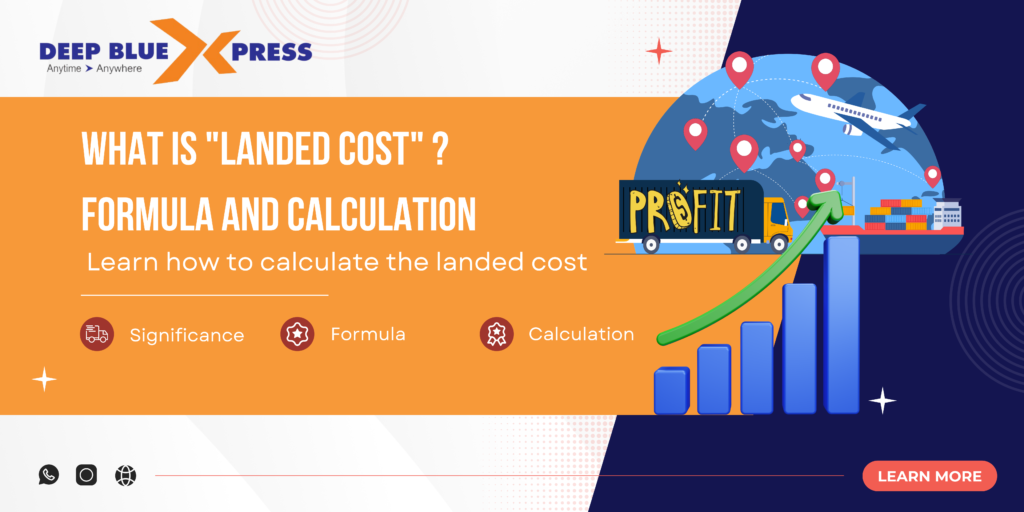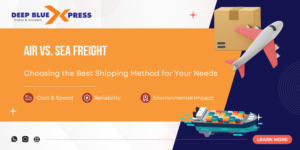Ecommerce Businesses looking to be profitable and make wise judgements in the world of international trade and commerce need to grasp the notion of landed cost. The term “landed cost” describes the entire cost of a product after it has reached its destination. This includes not just the purchase price but also a variety of other costs that were spent during the procurement process. At Deep Blue Xpress Limited, we understand how crucial it is for companies to understand landed cost and how it affects their operations in the linked economy of today. Let’s examine this important facet of global trade in order to understand its meaning, formula, and computation techniques.
What is landed cost?
The total of all the costs involved in shipping a product is called the “landed cost.” This usually refers to expenses such as taxes and fees associated with foreign shipping. To get the best pricing on your goods, you must be aware of the landed cost for each sort of product that your company imports or exports, as well as any regular international shipping to clients.
A crucial figure for owners of small businesses is the landed cost. Knowing your overseas shipping costs in advance will help you plan ahead for how to pay for them, turn a profit, and keep your rates competitive. For instance, the total landed cost is the lowest price at which you may sell a product that you are importing from India to the United States. You will not, however, benefit if you sell at this price. Price your imported product higher than its landed cost in order to make a profit.
What goes into your landed cost?
Let’s examine each of the expenses that go into calculating the landed cost in more detail. It’s crucial to keep in mind that not every expense listed above may be applicable to your company or to every foreign cargo you send or receive.
- Insurance: It’s necessary that your goods are insured. It safeguards you from misplaced, pilfered, or harmed items. But the category and value of the transported products determine how much it will cost.
- Customs: The import and export of products are subject to unique tariffs and laws in every nation. Shippers should plan a budget for customs-related expenses like as tariffs and duties; for further information, visit gov.
- Exchange rates: When finalizing product prices, it is important to consider the volatility of exchange rates over time. Currency exchange rates have a great deal of influence over small business owners.
- Costs for Demurrage: When containers remain inside a port or terminal after the permitted amount of time, shipping lines usually impose charges costs. For as long as the containers are left on site, these expenses go up.
- Export licence: Do your research before sending anything abroad, even if 95% of all Indian exports are exempt from this need. The Export Control Classification Number (ECCN) for your goods should be the first thing you look up since it will show you any licencing needs and possibly even the price.
- Port charges: Associated fees differ based on the destination of the package because different ports have different prices. Shippers may be assessed demurrage fees, early or late port charges, or even cancellation charges.
- Free on board (FOB): Although not a direct charge, FOB influences what you buy and, consequently, how much shipping will cost. FOB refers to the party responsible for goods destroyed in transportation. Therefore, taking this into consideration when determining prices is a great idea.
How to calculate total landed cost
You can calculate your total landing cost more precisely when you are aware of the potential costs. Since no two overseas shipments will be the same, only those related to each should be chosen. There is no export licence charge if you aren’t exporting goods. Similarly, if storage is not needed, you might not have to include demurrage charges.
The main components—product, transportation, customs, risk, and overhead—will assist in the computation of this figure. Product pricing and shipping costs can be changed after calculating the cost per unit, carrier fees, taxes, tariffs, and customs, as well as processing and insurance costs.
Landed cost formula & cost calculation with example:
Formula:
Product + shipping + customs + risk + overhead = landed cost
Add customs, which includes all applicable tariffs, taxes, and fees, to the cost of the product after deducting shipping and product expenses. The expense of safeguarding your investment, which may include quality assurance, compliance, and insurance, is then represented by risk. Furthermore, bank costs, currency conversion, and payment processing fees are also included in overhead.
For example,
Assume you paid ₹ 1668.79 per unit for 500 goods from a supplier. 2% of each item, or ₹ 33.38, is the duty (₹ 1668.79 x. 0.02). ₹ 83439.40 or ₹ 166.88 for each item (₹ 83439.40/500 products) is the shipping cost. Your insurance cost per unit is ₹ 16687.88/500 + ₹ 834.39, or ₹ 867.77. Additionally, insurance is ₹ 16687.88 plus an extra ₹ 834.39 per customer order. Additionally, each unit has a payment processing cost of ₹ 166.88.
Total landed cost = ₹ 1668.79 (product) + ₹ 166.88 (shipping per item) + ₹ 33.38 (duties) + ₹ 867.77 (insurance) + ₹ 166.88 (processing fee) = ₹ 2903.69per unit




